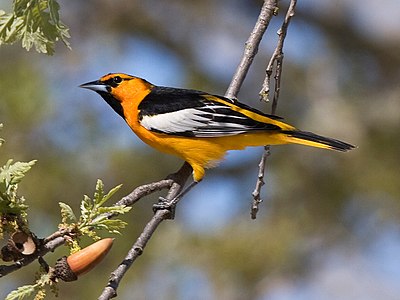Bullock Trupial
| Bullock Trupial | ||||||||||||
|---|---|---|---|---|---|---|---|---|---|---|---|---|

Bullock-Trupial ( Icterus bullockii ), male |
||||||||||||
| Systematics | ||||||||||||
|
||||||||||||
| Scientific name | ||||||||||||
| Icterus bullockii | ||||||||||||
| ( Swainson , 1827) |
The Bullock Trupial ( Icterus bullockii ) is a species of songbird from the family of starchlings (Icteridae) that occurs in North and Central America . The specific epithet honors the English naturalist William Bullock .
description
Appearance
Bullock-Trupiale reaches a total length of 19.0 to 23.0 centimeters and an average weight of 37.9 grams for the males and 37.8 grams for the females. In the males, the head, flanks, rump , chest and belly are bright orange yellow. A narrow spring cap, the throat and parts of the dorsal plumage and some control feathers are black, as is the reins. The hand covers and parts of the hand wings are white. There is a noticeable sexual dimorphism , as the females appear to be much less contrasting and pale in color. They have gray-green to yellow-gray plumage on the upper side and yellow-white to white-gray on the underside. Young birds are similar in color to the females. The iris is black-brown in both sexes. The upper beak is dark gray, the lower beak light gray. Legs and feet are slate gray.
Vocalizations
The singing of the Bullock Trupial is a loud, melodic string of whistling tones.
Vocal example
distribution and habitat
The breeding areas of the Bullock Trupiale extend along the west coast of Canada and the USA to northern Mexico . In addition to the nominate form Icterus bullockii bullockii , which occurs in the northern areas of distribution, another subspecies is known: Icterus bullockii parvus van Rossem , 1945, which is native to California , Nevada , Arizona and Mexico.
The wintering areas of the species are further south and reach as far as Guatemala . It prefers to live in open woodlands, olive groves ( Olea ) and savannahs rich in bushes with poplars ( Populus ), plane trees ( Platanus ), oaks ( Quercus ) or mesquite trees ( Prosopis ) . Bullocks Trupiale were found at altitudes of 3000 meters.
Way of life
The birds live in pairs or in small colonies together and are monogamous for one breeding season . They feed primarily on various insects and occasionally on berries , seeds , nuts and nectar . They sometimes also devour the black olive scale ( Saissetia oleae ), which sometimes appears as an agricultural pest in olive groves and is therefore welcome in agriculture. An examination of the stomach contents showed 79% animal and 21% vegetable food.
The nest is made at the top of twigs in the form of an approximately ten centimeter long, hanging bag made of plant fibers, dried up leaves, animal hair, feathers and elastic thin twigs. It is primarily woven by the female at heights between three and seven meters. Often several nests of smaller colonies are created close together. Sometimes they are placed near the nests of the yellow-billed magpie ( Pica nuttalli ) in order to achieve better protection from predators. The clutch number consists of three to seven eggs, which are laid from April. The eggs are pale bluish or grayish-white in color and have a few small brown spots on them. A second brood does not occur. The breeding season is around 12 days. Both parents feed the nestlings, which fly out after about 14 days. The adult birds are often able to recognize and remove eggs that have been pushed under them by parasitic brown-headed blackbirds ( Molothrus ater ) or red- eyed cowbirds ( Molothrus aeneus ).
Hazard and protection
The Bullock Trupial is not uncommon in its areas of distribution and is therefore classified by the World Conservation Organization IUCN as ![]() " least concern = not endangered". At present a global number of 3,800,000 birds is thought to be. The species is protected by the United States Fish and Wildlife Service under the Migratory Bird Treaty Act .
" least concern = not endangered". At present a global number of 3,800,000 birds is thought to be. The species is protected by the United States Fish and Wildlife Service under the Migratory Bird Treaty Act .
swell
literature
- Josep del Hoyo , Andrew Elliott, David A. Christie: Handbook of the Birds of the World. Volume 16: Tanagers to New World Blackbirds. Lynx Edicions, 2011, ISBN 978-84-96553-78-1 .
- Richard Crossly: The Crossly ID Guide , Princeton University Press, Barcelona 2011, ISBN 978-0-691-14778-9 .
Individual evidence
- ↑ a b c d e R. Fraga: Bullock's Oriole (Icterus bullockii). In: Josep del Hoyo, Andrew Elliott, Jordi Sargatal, David A. Christie, Eduardo de Juana (eds.): Handbook of the Birds of the World Alive. Lynx Edicions, Barcelona 2016 (retrieved from http://www.hbw.com/node/62251 on May 3, 2016).
- ^ IUCN Red List
Web links
- VIREO photos
- Bullock-Trupial (Icterus bullockii) in the Encyclopedia of Life . Retrieved August 11, 2017.



